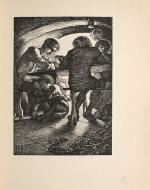Created by Andrea Aguiar on Sun, 11/08/2020 - 18:57
Description:
The Were-Wolf, written by Clemence Housman, is a short story first published in Atalanta: A Magazine for Girls in 1890, with these illustrations by Everard Hopkins. The story origniated as an oral tale that Housman told to the other women in her wood-engraving class. It was later published on its own in 1896 with John Lane at the Bodley Head, for which Laurence Housman completed the pen-and-ink illustrations and Clemence herself completed the wood engraving. Rol’s Worship is a full-page illustration that can be found facing page 8 of the second published version of the story, and it depicts Rol, the younger boy character, engaging in an act of ‘hero worship’ by clinging onto his older brother Sweyn’s leg. The scene for the story is set in this image, noticeable when the viewers consider the family sitting close together at the table under low light, and the imagery used sets the tone for the eerie story to come. Focus is placed on Rol’s act of worship of his brother Sweyn, setting implications for who Sweyn is and the idea that he will be of most importance for the rest of the story.
Housman, through her use of specific characters, is able to make commentary on Victorian gender roles and what traits are praised by those in society. When analyzing Rol’s actions in this image, it is easy to identify how he mirrors the ideology of the people around him. The title of this image, Rol’s Worship, suggests that Rol values the personality of his older brother Sweyn and looks up to him. The text suggests that Sweyn typically plays the hero, and as such is the portrait of the ideal Victorian man. He is described as the brave, masculine older brother who is praised by his family, including Rol as shown in this image, and ends up being the one attempting to stand up to White Fell when he learns of her true nature. The relationship between Sweyn and White Fell also makes commentary on the genre of the femme fatale, as Sweyn plays the role of the man who is infatuated with the beauty of White Fell and does not second guess the front that she gives to the family upon her first arrival at their home. Rol, regardless of the stories events, continues to consider his older brother a hero and knows that he wants to grow up to be like him, presenting the irony behind the image of ‘Rol’s Worship’ because the readers learn otherwise about Sweyn’s character.
Having the focus directed on Rol and Sweyn as the illustration does allows the viewers to reconsider Sweyn and his role at this current moment in the story. Viewers know that Sweyn is important not only because of the image title and relationship between him and Rol, but because he is pictured sitting at the head of the table, and therefore it can be assumed that he is the head of the household. As such he plays the crucial role of protecting his family, and is an example of everything that Rol wants to be when he grows up. With Housman’s placement of Rol in this position, it suggests the idea that children constantly idolize those around them and learn to mimic their actions. ‘Rol’s Worship’ depicts a scene where Rol is admiring his older brother’s bravery, the same bravery that Rol tries to have himself when he goes into the forest later in the story despite being told that it is dangerous to do so. Rol understands why people value Sweyn and wants to be viewed the same way, and so ‘Rol’s Worship’ exhibits a dynamic between the two that is of most importance for understanding Housman’s The Were-Wolf.
Source:
http://omeka-s.rula.info/s/werewolf/item/14#?c=&m=&s=&cv=&xywh=-973%2C-7...
Copyright:
Associated Place(s)
Timeline of Events Associated with Laurence Housman, "Rol's Worship," The Were-Wolf (1896)
Part of Group:
Featured in Exhibit:
Artist:
- Laurence Housman. Engraved by Clemence Housman.


